Establishment of a basis for administrative use of PestSurf
Annex 4
4 Comparison of risk assessment data produced by spray drift assessments, FOCUS SW and PestSurf
4.1 Chemical characteristics of the compound
| Compound: | Fluazinam |
| Dose: | 175 g ai/ha 4 times with approx. 10 days interval |
| Spraying time: | 1. June and forward |
| Crop: | Potatoes |
Table 4.1. Overview of chemical properties of fluazinam and the parameters used in the simulations.
Tabel 4.1. Oversigt over fluazinams kemiske egenskaber og parametrene brugt i simuleringerne.
| Chemical property | Condition | Recalculated values | |||
| Cas-no. | 79622-59-6 | ||||
| Molecular weight | 465.1 | ||||
| Form (acid, basic, neutral) | neutral | ||||
| pKa | |||||
| Water solubility | 0.071 µg/l | pH 7.0 | 20°C | ||
| log Kow | at pH | KowA- | |||
| log Kow | 3.56 | at pH | KowAH | 3.56 | |
| log Kow | at pH | KowAH+ | |||
| Vapor pressure, Pa | 1,1 × 10-3 (study from 1991) | 25°C | vapor pressure, Pa, 20°C | ||
| 2,3 × 10-5 (study from 1992) | 25°C | ||||
| 5.1 × 10-6 (RIVM) | 20°C | ||||
| Henry’s law constant | Calculated in Pestsurf | Recalculated value, dimensionless | |||
| Sorption properties in soil | |||||
| Freundlich exp | 1 | ||||
| Koc, l/kg | 1945 | ||||
| DT50 in soil, days | 56.6 | ||||
| DT50water | From experiment (0.8+1.2)/2=1 day | PestSurf input | |||
| DT50sedment | High sorption, degradation on sediment | ||||
| DT50water/sediment | Exp 1: 1 and <7 d, 100 ml vand, 1 % sediment. Exp 2: (2.9+3.2)/2=3.05 d | DT50, days | 3.5 | ||
| Sediment konc., µg/l | 10000 | ||||
| Hydrolysis | None | at pH 5 | (acid) | Indef | |
| 42 | at pH 7 | (neutral) | 65.2 | ||
| 6 | at pH 9 | (basic) | 6.94 × 10-5 | ||
| Photolysis | |||||
| quantum yield | φ = 2.60 × 10-4 | ||||
| Spectrum | 3.86 l.mol-1.cm-1 at 342 nm. | ||||
| Other | DT50= 1-2 days at pH 5 and 3 days at pH 9. | ||||
4.2 Concentration generated by spray
| Direct spray | FOCUS buffer zones | |||
| µg/l | Ditch | Stream | Pond | |
| µg/l | µg/l | µg/l | µg/l | |
| Fluazinam | 58.3 | 0.839 | 0.608 | 0.291 |
4.3 Concentrations generated by FOCUS SW
4.3.1 D3- Ditch
| Fluazinam | Ditch, D3 | |||||||
| Water | Sediment | |||||||
| Date | PEC | Date | TWAEC | Date | PEC | Date | TWAEC | |
| µg l-1 | µg l-1 | µg kg-1 | µg kg-1 | |||||
| Global max | 08-jul-92 | 0.614 | 27-jun-92 | 0.367 | ||||
| 1 d | 09-jul-92 | 0.131 | 27-jun-92 | 0.367 | 28-jun-92 | 0.162 | 27-jun-92 | 0.207 |
| 2 d | 10-jul-92 | 0.009 | 28-jun-92 | 0.211 | 29-jun-92 | 0.109 | 28-jun-92 | 0.186 |
| 4 d | 12-jul-92 | 0.001 | 30-jun-92 | 0.107 | 01-jul-92 | 0.054 | 30-jun-92 | 0.144 |
| 7 d | 15-jul-92 | 0 | 03-jul-92 | 0.062 | 04-jul-92 | 0.022 | 03-jul-92 | 0.102 |
4.3.2 D4 – Stream
| Fluazinam | Stream, D4 | |||||||
| Water | Sediment | |||||||
| Date | PEC | Date | TWAEC | Date | PEC | Date | TWAEC | |
| µg l-1 | µg l-1 | µg kg-1 | µg kg-1 | |||||
| Global max | 01-jun-85 | 0.497 | 07-dec-85 | 0.366 | ||||
| 1 d | 02-jun-85 | 0.005 | 05-dec-85 | 0.31 | 08-dec-85 | 0.324 | 10-dec-85 | 0.362 |
| 2 d | 03-jun-85 | 0.005 | 06-dec-85 | 0.26 | 09-dec-85 | 0.365 | 11-dec-85 | 0.349 |
| 4 d | 05-jun-85 | 0.004 | 08-dec-85 | 0.226 | 11-dec-85 | 0.299 | 11-dec-85 | 0.344 |
| 7 d | 08-jun-85 | 0.01 | 11-dec-85 | 0.18 | 14-dec-85 | 0.231 | 13-dec-85 | 0.317 |
4.3.3 D4 - Pond
| Fluazinam | Pond, D4 | |||||||
| Water | Sediment | |||||||
| Date | PEC | Date | TWAEC | Date | PEC | Date | TWAEC | |
| µg l-1 | µg l-1 | µg kg-1 | µg kg-1 | |||||
| Global max | 07-dec-85 | 0.083 | 12-dec-85 | 0.148 | ||||
| 1 d | 08-dec-85 | 0.074 | 08-dec-85 | 0.081 | 13-dec-85 | 0.146 | 12-dec-85 | 0.148 |
| 2 d | 09-dec-85 | 0.08 | 09-dec-85 | 0.077 | 14-dec-85 | 0.14 | 13-dec-85 | 0.147 |
| 4 d | 11-dec-85 | 0.062 | 11-dec-85 | 0.076 | 16-dec-85 | 0.128 | 14-dec-85 | 0.145 |
| 7 d | 14-dec-85 | 0.039 | 12-dec-85 | 0.069 | 19-dec-85 | 0.116 | 16-dec-85 | 0.139 |
4.3.4 Conclusion – FOCUS SW
The highest concentration is generated in the ditch (D3). It is caused by wind drift and the concentration becomes 0.614 µg/l. The D4 stream scenario shows the highest concentration in the sediment, 0.366 µg/kg. For all scenarios, the concentrations are lower than what is generated by the simpler assessments, but for the ditch and stream-scenarios the difference between the simple drift calculation and the FOCUS SW-simulation is rather small. For the ditch and the stream the concentrations are generated by drift, while for the pond the concentration peaks in December, and must be due to drainage contributions.
4.4 PestSurf
4.4.1 Sandy Catchment, stream
The distribution of concentrations was assessed in several steps. First, the maximum concentrations at each calculation point were listed, and the dates for the occurrence of the maximum were assessed. The points, for which the maximum value also represents a local maximum were selected for further analysis. The relevant values are listed in Table 4.2.
Table 4.2. Maximum concentrations (ng/l) of fluazinam simulated for each calculation point in the sandy catchment.
Tabel 4.2. Maximumskoncentrationer (ng/l) af fluazinam simuleret for hvert beregningspunkt i det sandede opland.
| FLUAZINAM | Maximum | Max.Time | Local maxima |
| ODDERBAEK 0.00 | 284 | 03-07-1998 09:09 | |
| ODDERBAEK 56.00 | 305 | 03-07-1998 09:09 | |
| ODDERBAEK 112.00 | 370 | 03-07-1998 09:00 | |
| ODDERBAEK 192.00 | 801 | 03-07-1998 08:39 | |
| ODDERBAEK 272.00 | 1241 | 03-07-1998 08:30 | |
| ODDERBAEK 278.00 | 1317 | 03-07-1998 08:30 | |
| ODDERBAEK 282.00 | 1368 | 03-07-1998 08:30 | |
| ODDERBAEK 298.50 | 1518 | 03-07-1998 08:30 | |
| ODDERBAEK 315.00 | 1672 | 03-07-1998 08:30 | |
| ODDERBAEK 317.50 | 1694 | 03-07-1998 08:30 | |
| ODDERBAEK 320.00 | 1715 | 03-07-1998 08:30 | |
| ODDERBAEK 410.00 | 2231 | 03-07-1998 08:30 | |
| ODDERBAEK 500.00 | 2502 | 03-07-1998 08:30 | |
| ODDERBAEK 513.00 | 2619 | 03-07-1998 08:30 | |
| ODDERBAEK 521.00 | 2695 | 03-07-1998 08:30 | |
| ODDERBAEK 622.00 | 3159 | 03-07-1998 08:30 | |
| ODDERBAEK 723.00 | 3498 | 03-07-1998 08:30 | |
| ODDERBAEK 733.00 | 3590 | 03-07-1998 08:30 | |
| ODDERBAEK 742.00 | 3639 | 03-07-1998 08:30 | |
| ODDERBAEK 789.50 | 3796 | 03-07-1998 08:30 | |
| ODDERBAEK 837.00 | 3959 | 03-07-1998 08:30 | |
| ODDERBAEK 848.00 | 4030 | 03-07-1998 08:30 | |
| ODDERBAEK 863.00 | 4120 | 03-07-1998 08:30 | |
| ODDERBAEK 956.00 | 4420 | 03-07-1998 08:30 | |
| ODDERBAEK 1049.00 | 4492 | 03-07-1998 08:30 | X |
| ODDERBAEK 1111.50 | 4304 | 23-07-2004 08:30 | |
| ODDERBAEK 1174.00 | 3873 | 23-07-2004 08:30 | |
| ODDERBAEK 1226.00 | 3636 | 23-07-2004 08:40 | |
| ODDERBAEK 1278.00 | 3539 | 23-07-2004 08:40 | |
| ODDERBAEK 1293.50 | 3494 | 23-07-2004 08:40 | |
| ODDERBAEK 1310.00 | 3418 | 23-07-2004 08:40 | |
| ODDERBAEK 1421.00 | 3248 | 13-07-2000 08:50 | |
| ODDERBAEK 1532.00 | 2882 | 03-07-1998 08:30 | |
| ODDERBAEK 1558.06 | 2559 | 03-07-1998 08:39 | |
| ODDERBAEK 1584.12 | 2461 | 03-07-1998 08:39 | |
| ODDERBAEK 1584.12 | 2461 | 03-07-1998 08:39 | |
| ODDERBAEK 1621.06 | 2454 | 03-07-1998 08:39 | |
| ODDERBAEK 1658.00 | 2529 | 03-07-1998 08:30 | |
| ODDERBAEK 1698.50 | 2696 | 03-07-1998 08:30 | |
| ODDERBAEK 1739.00 | 2813 | 03-07-1998 08:30 | X |
| ODDERBAEK 1801.50 | 2729 | 03-07-1998 08:30 | |
| ODDERBAEK 1864.00 | 2228 | 10-06-2000 08:30 | |
| ODDERBAEK 1977.00 | 1556 | 01-06-2001 09:50 | |
| ODDERBAEK 2090.00 | 1509 | 01-06-2001 10:00 | |
| ODDERBAEK 2098.00 | 1508 | 01-06-2001 10:00 | |
| ODDERBAEK 2105.00 | 1502 | 01-06-2001 10:00 | |
| ODDERBAEK 2131.00 | 1489 | 01-06-2001 10:00 | |
| ODDERBAEK 2157.00 | 1468 | 10-06-2000 10:00 | |
| ODDERBAEK 2168.00 | 1461 | 10-06-2000 10:00 | |
| ODDERBAEK 2179.00 | 1454 | 10-06-2000 10:00 | |
| ODDERBAEK 2268.50 | 1433 | 10-06-2000 10:00 | |
| ODDERBAEK 2358.00 | 1358 | 10-06-2004 10:00 | |
| ODDERBAEK 2363.50 | 1352 | 10-06-2004 10:00 | |
| ODDERBAEK 2372.00 | 1346 | 10-06-2004 10:00 | |
| ODDERBAEK 2427.00 | 1330 | 10-06-2004 10:00 | |
| ODDERBAEK 2482.00 | 1297 | 10-06-2004 10:00 | |
| ODDERBAEK 2609.00 | 1268 | 10-06-2004 10:00 | |
| ODDERBAEK 2736.00 | 1181 | 01-06-2003 10:00 | |
| ODDERBAEK 2831.00 | 1153 | 01-06-2003 10:00 | |
| ODDERBAEK 2926.00 | 1083 | 01-06-2001 11:00 | |
| ODDERBAEK 2958.50 | 1070 | 01-06-2001 11:00 | |
| ODDERBAEK 2991.00 | 1055 | 01-06-2001 11:00 | |
| ODDERBAEK 3029.50 | 1024 | 01-06-2005 11:00 | |
| ODDERBAEK 3068.00 | 971 | 01-06-2005 11:00 | |
| ODDERBAEK 3131.00 | 907 | 01-06-2005 11:00 | |
| ODDERBAEK 3194.00 | 871 | 01-06-2003 11:00 | |
| ODDERBAEK 3250.50 | 857 | 03-07-1998 08:30 | |
| ODDERBAEK 3307.00 | 934 | 03-07-1998 08:30 | |
| ODDERBAEK 3315.00 | 956 | 03-07-1998 08:30 | |
| ODDERBAEK 3323.00 | 1031 | 03-07-1998 08:30 | |
| ODDERBAEK 3355.50 | 1205 | 03-07-1998 08:30 | |
| ODDERBAEK 3388.00 | 1371 | 03-07-1998 08:30 | |
| ODDERBAEK 3438.50 | 1534 | 03-07-1998 08:30 | |
| ODDERBAEK 3489.00 | 1582 | 03-07-1998 08:30 | |
| ODDERBAEK 3499.50 | 1587 | 03-07-1998 08:30 | X |
| ODDERBAEK 3510.00 | 1582 | 03-07-1998 08:30 | |
| ODDERBAEK 3581.00 | 1437 | 03-07-1998 08:30 | |
| ODDERBAEK 3652.00 | 1258 | 03-07-1998 08:39 | |
| ODDERBAEK 3707.00 | 1254 | 03-07-1998 08:39 | |
| ODDERBAEK 3762.00 | 1147 | 03-07-1998 08:39 | |
| ODDERBAEK 3790.00 | 998 | 03-07-1998 08:39 | |
| ODDERBAEK 3818.00 | 787 | 04-06-1998 08:40 | |
| ODDERBAEK 3818.00 | 787 | 04-06-1998 08:40 | |
| ODDERBAEK 3884.00 | 759 | 03-07-1998 08:50 | |
| ODDERBAEK 3950.00 | 727 | 04-06-1998 08:49 | |
| ODDERBAEK 3998.00 | 682 | 04-06-1998 08:49 | |
| ODDERBAEK 4046.00 | 638 | 04-06-1998 09:00 | |
| ODDERBAEK 4047.50 | 638 | 04-06-1998 09:00 | |
| ODDERBAEK 4049.00 | 638 | 04-06-1998 09:00 | |
| ODDERBAEK 4052.50 | 638 | 04-06-1998 09:00 | |
| ODDERBAEK 4056.00 | 637 | 04-06-1998 09:00 | |
| ODDERBAEK 4058.00 | 637 | 04-06-1998 09:00 | |
| ODDERBAEK 4060.00 | 637 | 04-06-1998 09:00 | |
| ODDERBAEK 4080.00 | 633 | 04-06-1998 09:00 | |
| ODDERBAEK 4100.00 | 629 | 04-06-1998 09:00 | |
| ODDERBAEK 4134.00 | 627 | 25-06-2005 09:00 | |
| ODDERBAEK 4168.00 | 628 | 25-06-2005 09:00 | |
| GISLUM_ENGE_AFLOEB 0.00 | 0 | 04-06-1998 08:10 | |
| GISLUM_ENGE_AFLOEB 50.00 | 0 | 04-06-1998 08:10 | |
| GISLUM_ENGE_AFLOEB 100.00 | 0 | 04-06-1998 08:10 | |
| GISLUM_ENGE_AFLOEB 150.00 | 0 | 04-06-1998 08:10 | |
| GISLUM_ENGE_AFLOEB 200.00 | 0 | 04-06-1998 08:10 | |
| GISLUM_ENGE_AFLOEB 250.00 | 0 | 04-06-1998 08:10 | |
| GISLUM_ENGE_AFLOEB 300.00 | 0 | 04-06-1998 08:10 | |
| GISLUM_ENGE_AFLOEB 340.00 | 0 | 04-06-1998 08:10 | |
| GISLUM_ENGE_AFLOEB 380.00 | 0 | 04-06-1998 08:10 | |
| GISLUM_ENGE_AFLOEB 430.00 | 0 | 04-06-1998 08:10 | |
| GISLUM_ENGE_AFLOEB 480.00 | 0 | 04-06-1998 08:10 | |
| GISLUM_ENGE_AFLOEB 530.00 | 0 | 04-06-1998 08:10 | |
| GISLUM_ENGE_AFLOEB 580.00 | 0 | 04-06-1998 08:10 | |
| GISLUM_ENGE_AFLOEB 630.00 | 0 | 04-06-1998 08:10 | |
| GISLUM_ENGE_AFLOEB 680.00 | 0 | 04-06-1998 08:10 | |
| GISLUM_ENGE_AFLOEB 730.00 | 0 | 04-06-1998 08:10 | |
| GISLUM_ENGE_AFLOEB 780.00 | 0 | 03-07-1998 09:09 | |
| GISLUM_ENGE_AFLOEB 830.00 | 0 | 03-07-1998 09:09 | |
| GISLUM_ENGE_AFLOEB 880.00 | 0 | 03-07-1998 09:09 | |
| GISLUM_ENGE_AFLOEB 915.00 | 0 | 03-07-1998 09:09 | |
| GISLUM_ENGE_AFLOEB 950.00 | 0 | 03-07-1998 09:09 | |
| GISLUM_ENGE_AFLOEB 985.00 | 0 | 03-07-1998 09:00 | |
| GISLUM_ENGE_AFLOEB 1020.00 | 0 | 03-07-1998 09:00 | |
| GISLUM_ENGE_AFLOEB 1045.00 | 0 | 03-07-1998 09:00 | |
| GISLUM_ENGE_AFLOEB 1070.00 | 0 | 03-07-1998 09:00 | |
| GISLUM_ENGE_AFLOEB 1110.00 | 0 | 03-07-1998 09:00 | |
| GISLUM_ENGE_AFLOEB 1150.00 | 0 | 03-07-1998 09:00 | |
| GISLUM_ENGE_AFLOEB 1190.00 | 1 | 03-07-1998 09:00 | |
| GISLUM_ENGE_AFLOEB 1230.00 | 2 | 03-07-1998 09:00 | |
| GISLUM_ENGE_AFLOEB 1271.00 | 5 | 03-07-1998 08:50 | |
| GISLUM_ENGE_AFLOEB 1312.00 | 15 | 03-07-1998 08:50 | |
| GISLUM_ENGE_AFLOEB 1422.00 | 164 | 03-07-1998 08:50 | |
| GISLUM_ENGE_AFLOEB 1532.00 | 787 | 04-06-1998 08:40 | |
| TILLOEB 0.00 | 2372 | 03-07-1998 08:39 | |
| TILLOEB 20.16 | 2425 | 03-07-1998 08:39 | |
| TILLOEB 40.31 | 2461 | 03-07-1998 08:39 | |
| global max | 4492 |
The pattern over time was the same for all calculation points. The peak values are generated by wind drift, see Figure 4.1.
Each of the events generated an almost identical pattern along the stream, see Figure 4.2 and Figure 4.3. The thin black line represents the concentration, while the thick line shows the maximum concentrations obtained during the simulations. In addition, the outline of the stream is shown. In the middle of the catchment, the stream is protected by unsprayed areas.The maximum values at the center of the catchment are obtained when the peak from upstream move through the catchment during the hours following spraying.
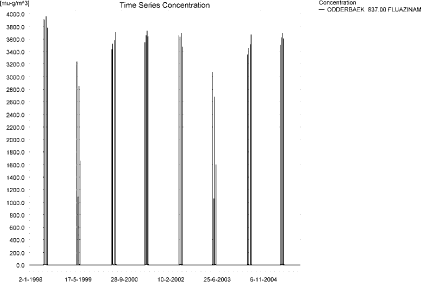
Figure 4.1. Concentration pattern over time for fluazinam in the sandy catchment.
Figur 4.1. Koncentrationsmønster som funktion af tid for fluazinam i det sandede opland.
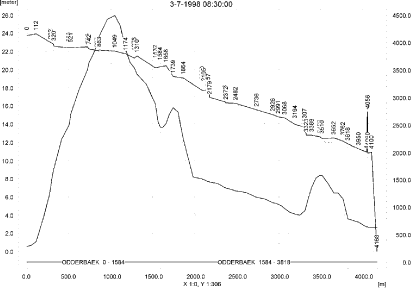
Figure 4.2. Concentrations of fluazinam in the sandy catchment on 3.July, 1998, at the end of 30 minutes’ spraying.
Figur 4.2. Koncentrationer af fluazinam i det sandede opland den 3. juli 1998 lige efter endt sprøjtning.
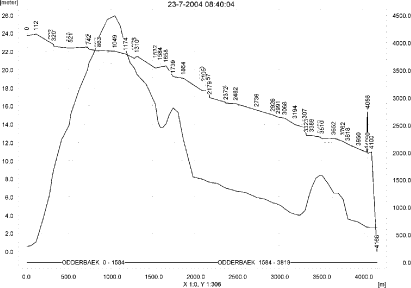
Figure 4.3. Concentrations of fluazinam in the sandy catchment on 23.July, 2004, 10 minutes after spraying ended.
Figur 4.3. Koncentrationer af fluazinam i det sandede opland den 23. juli 2004 10 minutter efter endt sprøjtning.
In order to present the data in a similar fashion to the FOCUS SW-results, data were extracted and recalculated for the time series marked in Table 4.2. The global maxima and time weighted concentrations (up to 7 days) were extracted and are reported in Table 4.3. Note that the unit is ng/l.
Table 4.3. Concentration of fluazinam, ng/l, at selected points in the sandy stream.
Tabel 4.3. Beregnet og tidsvægtet koncentration af fluazinam, ng/l, på udvalgte lokaliteter i det sandede vandløb.
An example of the amount of pesticide sorbed to macrophytes is shown in Figure 4.4. In this case, about 1/7 of the solute in the water phase is present in the macrophytes. The concentration in the water phase is therefore significantly influenced by the presence of macrophytes. The porewater concentrations are shown in Figure 4.5. The concentrations are very low. The maximum sorption to sediment is 2 ng/kg.
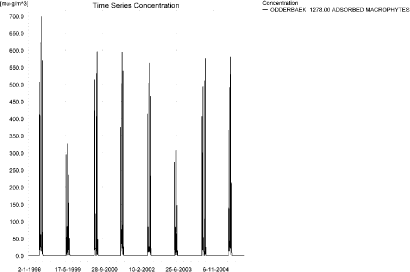
Figure 4.4. Concentration pattern for fluazinam sorbed on macrophytes. The maximum value, 704 ng/l, is reached 1421 m from the top end.
Figur 4.4. Koncentrationsmønster for fluazinam sorberet på makrofytter. Maximumsværdien, 704 ng/l nås 1421 m fra topenden.
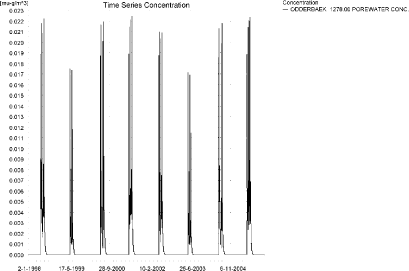
Figure 4.5. Porewater concentration of fluazinam in the sandy catchment. The maximum value, 0.025 ng/l, is reached 1049 m from the top end.
Figur 4.5. Porevandskoncentration for fluazinam i det sandede opland. Maximumsværdien, 0.025 ng/l opnås 1049 m fra topenden.
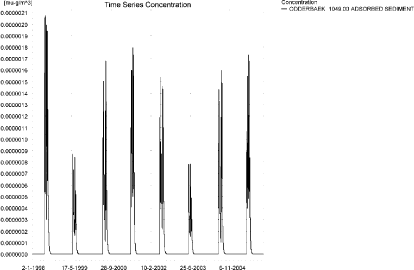
Figure 4.6. Sediment concentration of fluazinam in the sandy catchment. Note that the unit is µg/g and not µg/m³ as indicated.
Figur 4.6. Sedimentkoncentration for fluazinam i det sandede opland. Bemærk at koncentrationen er i µg/g og ikke i µg/m³ som angivet.
The global maximum value calculated by PestSurf for the sandy catchment in the water phase is 4.492 µg/l. This is considerably more than what is found in the D3-ditch scenario (614 ng/l), particularly when the macrophyte influence is taken into account. This is due to the accumulation of drift over a considerable length of the stream. However, 100 m from the upstream end, which could be compared to the ditch scenario, the concentration is only 370 ng/l.
The sediment concentration is much higher in the FOCUS SW D3-ditch (367 ng/kg) than in the PestSurf calculation (2 ng/kg).
Figure 4.7 shows the output of the PestSurf Excel template. The template works with pre-defined data extraction points. The plot requires specification of a “lowest detection value” (ldc) which defines when a pesticide occurrence is defined as an event.
The time series plot is identical to the time series shown earlier, and the graph in the upper right corner resembles the plots in Figure 4.2 and Figure 4.3, but takes into account a longer period of time. A curve is generated when a downstream point reaches a concentration higher than the ldc. The programme then tracks the highest concentration for each calculation point in the stream within the last 24 hours. The plot in the lower right corner shows how many events have concentrations higher than a given value for the selected monitoring points.
Table 4.4 shows part of the result sheet generated by the PestSurf Excel sheet. The selected table shows the point along the stream (of the pre-defined points) with the highest concentration. This value was, however, only 2.45 µg/l. Thus, the pre-defined points have not caught the highest concentration of the simulation, which was 4.49 µg/l.
Figure 4.7. Overview for fluazinam in the sandy catchment generated by the PestSurf excel template. The max concentrations generated over the 24 hours are similar to the overviews in Figure 4.2 and Figure 4.3. The graph to the lower right shows how many events have concentrations higher than a given value for the selected monitoring points. Detection value was 1 ng/l.
Figur 4.7. Oversigt for fluazinam i det sandede opland genereret med PestSurf-excel-skabelonen. Den maximale koncentration genereret over 24 timer svarer til oversigterne i Figur 4.2 og Figur 4.3. Grafen nederst til højre viser hvor mange hændelser, der har koncentrationer højere end en given værdi i et udvalgt punkt. Detektionsgrænsen var sat til 1 ng/l.
Table 4.4. Part of the result sheet generated by the PestSurf Excel sheet. The selected table shows the point along the stream with the highest concentration recorded. The detection values applied in the table is 1 ng/l, toxicity to fish, daphnies and algae are set to 10, 100 and 1000 ng/, respectively. The recorded peaks are shown in Figure 4.7.
Tabel 4.4. Uddrag af resultatpresentationen genereret af PestSurf-Excel-arket. Den udvalgte tabel viser det fordefinerede punkt langs med åen med højest koncentration. Detektionsgrænsen er sat til 1 mens toxicitetsværdierne for fisk, dafnier og alger er henholdsvis 10, 100 og 1000 ng/l. De tabellerede hændelser er vist i Figur 4.7.
4.4.2 Sandy Catchment, pond
The concentration pattern is evaluated in the middle of the pond only, see Figure 4.8. The pond receives drift but the contribution through groundwater dominates the picture. The highest concentrations are found in the early spring after a wet period. The maximum concentration is 5.88 µg/l.
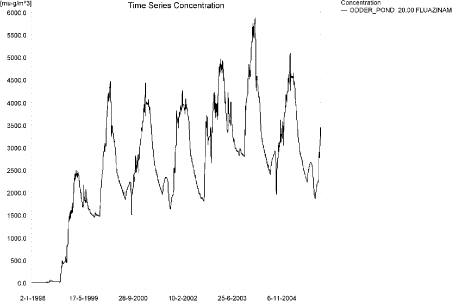
Figure 4.8. Concentrations of fluazinam in the sandy pond.
Figur 4.8. Koncentration af fluazinam i det sandede vandhul.
In Table 4.5, global maxima and time weighted concentrations (up to 7 days) were extracted.
Table 4.5. Maximum concentrations of fluazinam (ng/l) generated for the sandy pond.
Tabel 4.5. maximumkoncentrationer af fluazinam(ng/l) genereret for det sandede vandhul.
| Year | ODDER_POND 20.00, | |||
| Conc. | TWA | Date | ||
| 1998 | 1998 (global max) | 845 | 29/12/1998 | |
| 1 hour (after max) | ||||
| 1 day after sp.in. | 828 | 836 | ||
| 2 (3*) days | 804 | 820 | ||
| 4 days | 820 | 818 | ||
| 7 (6*) days | 898 | 832 | ||
| 1999 | 1999 (global max) | 2486 | 29/03/1999 | |
| 1 hour (after max) | ||||
| 1 day after sp.in. | 2417 | 2452 | ||
| 2 (3*) days | 2428 | 2414 | ||
| 4 days | 2392 | 2413 | ||
| 7 (6*) days | 2417 | 2414 | ||
| 2000 | 2000 (global max) | 4469 | 10/03/2000 | |
| 1 hour (after max) | ||||
| 1 day after sp.in. | 4426 | 4447 | ||
| 2 (3*) days | 4255 | 4402 | ||
| 4 days | 4057 | 4341 | ||
| 7 (6*) days | 3731 | 4155 | ||
| 2001 | 2001 (global max) | 4422 | 26/02/2001 | |
| 1 hour (after max) | ||||
| 1 day after sp.in. | 4417 | 4420 | ||
| 2 (3*) days | 4000 | 4308 | ||
| 4 days | 3699 | 4193 | ||
| 7 (6*) days | 3977 | 4072 | ||
| 2002 | 2002 (global max) | 4271 | 07/03/2002 | |
| 1 hour (after max) | ||||
| 1 day after sp.in. | 4033 | 4152 | ||
| 2 (3*) days | 3937 | 4017 | ||
| 4 days | 3941 | 3998 | ||
| 7 (6*) days | 3952 | 3977 | ||
| 2003 | 2003 (global max) | 4968 | 29/03/2003 | |
| 1 hour (after max) | ||||
| 1 day after sp.in. | 4826 | 4897 | ||
| 2 (3*) days | 4840 | 4818 | ||
| 4 days | 4768 | 4814 | ||
| 7 (6*) days | 4830 | 4818 | ||
| 2004 | 2004 (global max) | 5883 | 10/03/2004 | |
| 1 hour (after max) | ||||
| 1 day after sp.in. | 5823 | 5853 | ||
| 2 (3*) days | 5595 | 5791 | ||
| 4 days | 5336 | 5710 | ||
| 7 (6*) days | 4905 | 5465 | ||
| 2005 | 2005 (global max) | 5097 | 26/02/2005 | |
| 1 hour (after max) | ||||
| 1 day after sp.in. | 5086 | 5091 | ||
| 2 (3*) days | 4607 | 4961 | ||
| 4 days | 4259 | 4829 | ||
| 7 (6*) days | 4566 | 4686 | ||
| Global max | 5883 | |||
| 1 hour (after max) | ||||
| 1 day after sp.in. | 5823 | 5853 | ||
| 2 (3*) days | 5595 | 5791 | ||
| 4 days | 5336 | 5710 | ||
| 7 (6*) days | 4905 | 5465 | ||
The sorption to macrophytes is shown in Figure 4.9. The pattern follows closely the concentration in the water, and the concentration is 1/4-1/5 of the concentration in the water phase. The concentration in the water phase is therefore significantly influenced by the presence of macrophytes. Time series of porewater concentration and fluazinam sorbed to sediment are shown in Figure 4.10 and Figure 4.11. The highest concentration recorded is 2.84 µg/kg sediment.
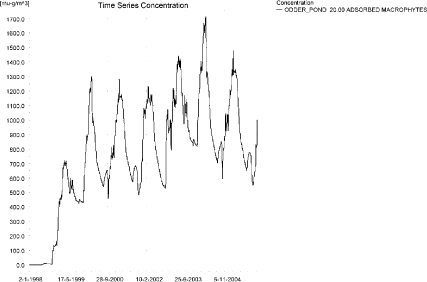
Figure 4.9. Sorption of fluazinam to macrophytes in the sandy pond.
Figur 4.9. Sorption af fluazinam til makrofytter i det sandede vandhul.
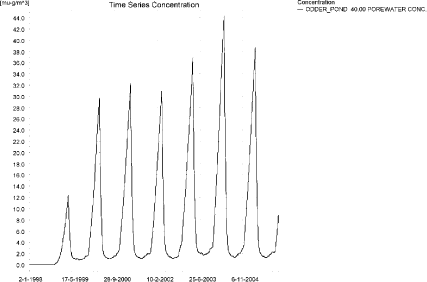
Figure 4.10. Pore water concentration of fluazinam in the sandy pond.
Figur 4.10. Porevandskoncentration af fluazinam i det sandede vandhul.
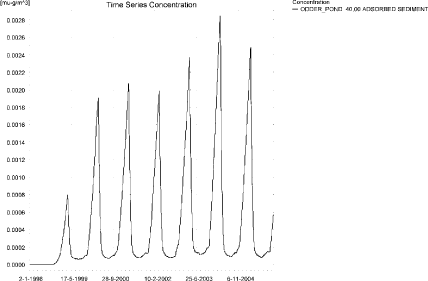
Figure 4.11. Sorption of fluazinam to sediment in the sandy pond. The concentration is in µg/g sediment and not µg/m³ as stated.
Figur 4.11. Sorption af fluazinam til ediment i det sandede vandhul. Bemærk at koncentrationen er i µg/g og ikke i µg/m³ som angivet.
Compared to the FOCUS D3 ditch, the concentration in the PestSurf sandy pond is considerably higher, 5.88 µg/l compared to 0.131 µg/l. The ditch-concentration is caused by wind drift while the concentration in the sandy pond is caused by groundwater contribution. The concentration in the sediment is also higher in PestSurf, 2.84 µg/kg compared to 0.367 µg/kg in the FOCUS SW-D3-ditch.
Figure 4.12 shows the output of the PestSurf Excel template. The template works with one pre-defined data extraction point for the pond (center of the pond). The plot requires specification of a “lowest detection value” (ldc) which defines when a pesticide occurrence is defined as an event. The time series plot is identical to the time series shown earlier. The plot to the right shows how many events have concentrations higher than a given toxicity value for the selected monitoring points. In the pond-case, there is no difference between the results of PestSurf and the results extracted by the templates.
Table 4.12 shows part of the result sheet generated by the PestSurf Excel sheet based on the ldc-value.
Click here to see Figure 4.12.
Figure 4.12. Overview for fluazinam in the sandy pond generated by the PestSurf excel template. The time series shown is identical to the one in Figure 4.8. The detection value is set to 3000 ng/l.
Figur 4.12. Oversigt for fluazinam i det sandede vandhul genereret med PestSurf-excel-skabelonen. Den viste tidsserie er mage til den i Figur 4.8. Detektionsgrænsen er sat til 3000 ng/l.
Table 4.6. Part of the result sheet generated by the PestSurf Excel sheet, applied to fluazinam. The limiting values applied in the simulation is lowest detection valuε = 3000 ng/l, toxicity to fish, daphnies and algae are set to 4000, 5000 and 10000 ng/, respectively. The recorded peaks are shown in Figure 4.12. EOF: End of File.
Tabel 4.6. Uddrag af resultatpresentationen genereret af PestSurf-Excel-arket anvendt på fluazinam. Grænseværdien anvendt til tabelgenerering er sat til 3000 ng/l mens toxicitetsværdierne for fisk, dafnier og alger er henholdsvis 4000, 5000 og 10000 ng/l. De tabellerede hændelser er vist i Figur 4.12. EOF: slutning af filen.
4.4.3 Sandy Loam catchment, Stream
The distribution of concentrations was assessed in several steps. First, the maximum concentrations at each calculation point were listed, and the dates for the occurrence of the maximum were assessed. The points, for which the maximum value also represents a local maximum were selected for further analysis.
All points show the same type of time series pattern. The eight points with highest maximum values were analysed further.
Table 4.7. Maximum concentrations (ng/l) of fluazinam simulated for each calculation point in the sandy loam catchment.
Tabel 4.7. Maximumskoncentrationer (ng/l) af fluazinam simuleret for hvert beregningspunkt i morænelersoplandet.
| FLUAZINAM | Maximum | Max.Time | Local Maxima |
| ALBJERGBAEK 0.00 | 646 | 28-12-2001 00:00 | |
| ALBJERGBAEK 150.00 | 876 | 26-12-2001 00:00 | |
| ALBJERGBAEK 300.00 | 712 | 28-12-2001 00:00 | |
| ALBJERGBAEK 450.00 | 775 | 28-12-2001 00:00 | |
| ALBJERGBAEK 600.00 | 2407 | 31-05-2001 09:10 | |
| ELHOLTBAEK 0.00 | 116 | 30-10-1998 00:00 | |
| ELHOLTBAEK 165.00 | 77 | 29-08-1998 00:00 | |
| ELHOLTBAEK 330.00 | 11366 | 18-09-1998 00:00 | |
| FREDLIGBAEK 0.00 | 12413 | 18-09-1998 00:00 | |
| FREDLIGBAEK 100.00 | 19683 | 18-09-1998 00:00 | |
| FREDLIGBAEK 200.00 | 20975 | 18-09-1998 00:00 | |
| FREDLIGBAEK 300.00 | 21266 | 18-09-1998 00:00 | |
| FREDLIGBAEK 400.00 | 21059 | 18-09-1998 00:00 | |
| FREDLIGBAEK 500.00 | 21428 | 18-09-1998 00:00 | |
| FREDLIGBAEK 600.00 | 20259 | 18-09-1998 00:00 | |
| FREDLIGBAEK 667.50 | 23327 | 18-09-1998 00:00 | X |
| FREDLIGBAEK 735.00 | 14346 | 18-09-1998 00:00 | |
| GROFTEBAEK 0.00 | 835 | 26-10-1998 00:00 | |
| GROFTEBAEK 155.00 | 1405 | 26-10-1998 00:00 | |
| GROFTEBAEK 310.00 | 1448 | 26-10-1998 00:00 | |
| GROFTEBAEK 465.00 | 993 | 03-11-2000 00:00 | |
| GROFTEBAEK 620.00 | 12771 | 18-09-1998 00:00 | |
| STENSBAEK 0.00 | 379 | 08-09-1998 00:00 | |
| STENSBAEK 125.00 | 25025 | 18-09-1998 00:00 | X |
| STENSBAEK 250.00 | 14775 | 18-09-1998 00:00 | |
| STENSBAEK 412.50 | 26398 | 18-09-1998 00:00 | X |
| STENSBAEK 575.00 | 18248 | 18-09-1998 00:00 | |
| OVRELILLEBAEK 0.00 | 159 | 30-10-1998 00:00 | |
| OVRELILLEBAEK 125.00 | 5380 | 31-05-1998 08:30 | |
| OVRELILLEBAEK 250.00 | 5653 | 21-06-1996 08:30 | |
| OVRELILLEBAEK 290.00 | 6353 | 31-05-1999 08:30 | |
| OVRELILLEBAEK 330.00 | 2407 | 31-05-2001 09:10 | |
| OVRELILLEBAEK 330.00 | 2407 | 31-05-2001 09:10 | |
| OVRELILLEBAEK 352.50 | 3826 | 21-06-1996 08:30 | |
| OVRELILLEBAEK 375.00 | 18248 | 18-09-1998 00:00 | |
| OVRELILLEBAEK 375.00 | 18248 | 18-09-1998 00:00 | |
| OVRELILLEBAEK 437.50 | 19551 | 18-09-1998 00:00 | X |
| OVRELILLEBAEK 500.00 | 17023 | 18-09-1998 00:00 | |
| OVRELILLEBAEK 625.00 | 18916 | 18-09-1998 00:00 | X |
| OVRELILLEBAEK 750.00 | 13581 | 18-09-1998 00:00 | |
| OVRELILLEBAEK 855.00 | 13674 | 18-09-1998 00:00 | |
| OVRELILLEBAEK 960.00 | 11366 | 18-09-1998 00:00 | |
| OVRELILLEBAEK 960.00 | 11366 | 18-09-1998 00:00 | |
| OVRELILLEBAEK 980.00 | 12757 | 18-09-1998 00:00 | |
| OVRELILLEBAEK 1000.00 | 12681 | 18-09-1998 00:00 | |
| OVRELILLEBAEK 1062.50 | 13931 | 18-09-1998 00:00 | |
| OVRELILLEBAEK 1125.00 | 13633 | 18-09-1998 00:00 | |
| OVRELILLEBAEK 1187.50 | 14349 | 18-09-1998 00:00 | x |
| OVRELILLEBAEK 1250.00 | 12170 | 18-09-1998 00:00 | |
| OVRELILLEBAEK 1425.00 | 12589 | 18-09-1998 00:00 | |
| OVRELILLEBAEK 1600.00 | 10818 | 18-09-1998 00:00 | |
| OVRELILLEBAEK 1650.00 | 10679 | 18-09-1998 00:00 | |
| OVRELILLEBAEK 1700.00 | 10234 | 18-09-1998 00:00 | |
| NEDRELILLEBAEK 0.00 | 10234 | 18-09-1998 00:00 | |
| NEDRELILLEBAEK 135.00 | 10224 | 18-09-1998 00:00 | |
| NEDRELILLEBAEK 270.00 | 9985 | 18-09-1998 00:00 | |
| NEDRELILLEBAEK 330.00 | 10587 | 18-09-1998 00:00 | |
| NEDRELILLEBAEK 390.00 | 12132 | 18-09-1998 00:00 | |
| NEDRELILLEBAEK 495.50 | 13339 | 18-09-1998 00:00 | |
| NEDRELILLEBAEK 601.00 | 14346 | 18-09-1998 00:00 | |
| NEDRELILLEBAEK 601.00 | 14346 | 18-09-1998 00:00 | |
| NEDRELILLEBAEK 693.00 | 14503 | 18-09-1998 00:00 | |
| NEDRELILLEBAEK 785.00 | 14235 | 18-09-1998 00:00 | |
| NEDRELILLEBAEK 847.00 | 15554 | 20-06-2001 08:30 | x |
| NEDRELILLEBAEK 909.00 | 12771 | 18-09-1998 00:00 | |
| NEDRELILLEBAEK 909.00 | 12771 | 18-09-1998 00:00 | |
| NEDRELILLEBAEK 984.50 | 12799 | 18-09-1998 00:00 | |
| NEDRELILLEBAEK 1060.00 | 12794 | 18-09-1998 00:00 | |
| NEDRELILLEBAEK 1169.50 | 13529 | 20-06-2001 08:30 | |
| NEDRELILLEBAEK 1279.00 | 17167 | 20-06-2001 08:30 | x |
| NEDRELILLEBAEK 1409.50 | 12941 | 18-09-1998 00:00 | |
| NEDRELILLEBAEK 1540.00 | 13002 | 18-09-1998 00:00 | |
| global max | 26398 |
Most maximum concentrations are caused by drainage events. Figure 4.13, Figure 4.14 and Figure 4.15 show the concentration pattern as it appears in the upper and lower part of the stream. Three patterns stand out: the extreme event in September 1998, the drift contribution and a buildup in groundwater over time. The extreme event causes maximum concentrations almost all over the catchment. Drift is important in some upstream-points in Ovrelillebaek and in the lower part of the catchment, where the combined effect of groundwater contribution and drift causes high concentrations. In this part of the stream, high concentrations are reached during the last summer, where the flow in the stream in the lower part of the catchment is generated mainly by baseflow. The concentration level falls again at the end of the simulation, so no further buildup of concentration levels would be expected.
The maximum value is generated in a tributary to the main stream. For the main stream, the three maximum concentrations are generated between 375 and 625 m from the top end by the extreme event. Slightly lower concentrations are generated near the end of the catchment by a combination of drift and groundwater contribution.
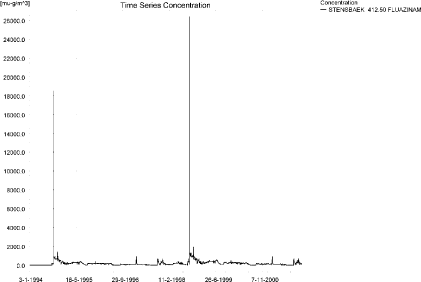
Figure 4.13. Concentration pattern for fluazinam in the upstream part of the sandy loam catchment, which represents OvreLillebaek, Fredligbaek and Steensbaek.
Figur 4.13. Koncentrationsmønster for fluazinam i den opstrøms ende af morænelersoplandet, der repræsenterer Øvre lillebæk, fredligbæk og steensbæk.
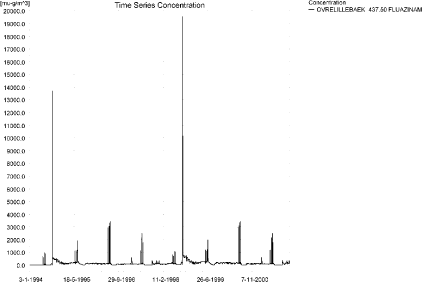
Figure 4.14. Concentration pattern for fluazinam inthe upstream part of OvreLillebaek The drift contributions increase in importance as the effect accumulates.
Figur 4.14. Koncentrationsmønster for fluazinam i den opstrøms ende af Øvre lillebæk. Drifttilskuddets betydning øges efterhånden som effekten akkumuleres.
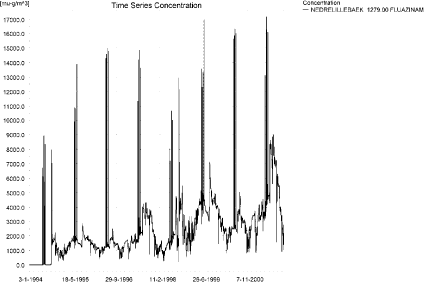
Figure 4.15. Concentration pattern for Fluazinam in NedreLillebaek, representing the lower part of the sandy loam catchment.
Figur 4.15. Koncentrationsmønster for fluazinam i Nedre Lillebæk, der repræsenterer den nedstrøms ende af morænelersoplandet.
Two concentration profiles are presented in this case to illustrate the extreme event and the joint impact of drift and groundwater contribution. The thin black line represents the concentration, while the thick black line shows the maximum concentrations obtained during the simulations. In addition, the outline of the stream is shown.
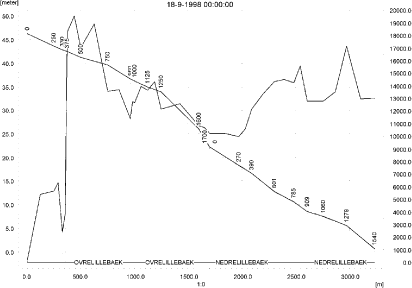
Figure 4.16. Concentrations in the sandy loam catchment on 18. September-1998. The concentrations are generated by the 20-year event, and most of the catchment reaches it maximum value at this date.
Figur 4.16. Koncentrationer i morænelersoplandet den 18 september-1998. Koncentrationerne genereres af 20-års-hændelsen, og størstedelen af oplandet opnår maximumsværdier på denne dato.
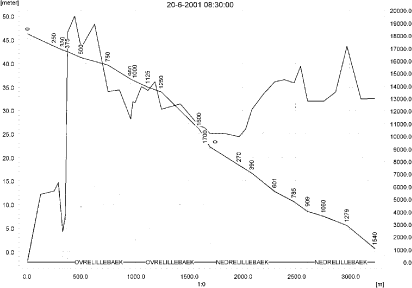
Figure 4.17. Concentrations in the sandy loam catchment on 20. June 2001. Concentrations in the top of the catchment are generated by drift alone, while the groundwater contribution is important in most of Nedrelillebaek.
Figur 4.17. Koncentrationer i morænelersoplandet den 20. juni-2001. Koncentrationer i topenden af oplandet genereres alene af drift mens grundvandstilstrømning er væsentlig i det meste af nedre Lillebæk.
To be able to extract comparable values to FOCUS SW, the global maxima and time weighted concentrations (up to 7 days) were extracted when these were meaningful.
Figure 4.18 and Figure 4.19 show the concentrations sorbed to macrophytes and Figure 4.20 the concentration of pesticide in porewater. The amount of pesticide sorbed to sediment is shown in Figure 4.21. The pattern of sorption to macrophytes follows the pattern of the water concentrations. The concentration level at the maximum point is more than five times the concentration in the water phase and the simulation results are therefore strongly influenced by the presence of macrophytes. At other sites the concentration in macrophytes and in the water phase are similar. The adsorption to sediment follows the concentration in the porewater. The maximum concentration reached is about 485 ng/kg in the downstream end of the catchment.
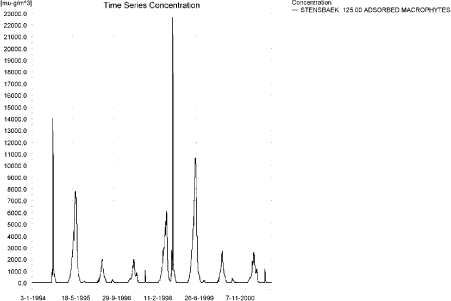
Figure 4.18. Pattern for concentration of fluazinam on macrophytes in the upstream part of the sandy loam catchment, which represents OvreLillebaek, Fredligbaek and Steensbaek.
Figur 4.18. Koncentrationsmønster af fluazinam på makrofytter i den opstrøms ende af morænelersoplandet, der repræsenterer Øvre Lillebæk, Fredligbæk og Steensbæk.
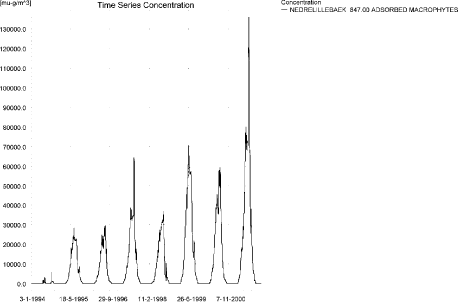
Figure 4.19. Concentration of fluazinam on macrophytes in the lower part of the sandy loam catchment.
Figur 4.19. Koncentration af fluazinam på makrofytter i den nedstrøms ende af morænelersoplandet.
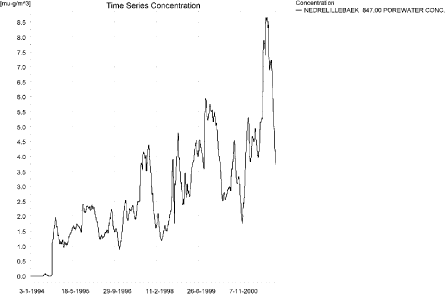
Figure 4.20. Concentration of fluazinam in porewater The highest concentration, 8.71 ng/l is reached 60 m further downstream from this point.
Figur 4.20. Porevandskoncentration i den nedstrøms del af morænelersoplandet. Den højeste koncentration, 8.71 ng/l opnås 60 m nedstrøms af det viste punkt.
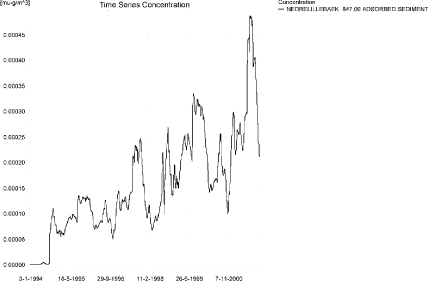
Figure 4.21. Concentration of fluazinam adsorbed to sediment in the downstream end of the sandy loam catchment for the point with the highest concentration reached. The concentration is in µg/g sediment and not µg/m³ as stated.
Figur 4.21. Koncentration af fluazinam sorberet til sediment i den nedstrøms ende af morænelersoplandet i lokaliteten med den højeste opnåede koncentration. Koncentrationen er i µg/g sediment og ikke µg/m³ som angivet.
The FOCUS SW-prediction and the PestSurf prediction for a sandy loam stream are quite different. FOCUS SW generates 497 ng/l while PestSurf generates 26.4 µg/l, or – in the main stream, 19.6 µg/l. In FOCUS SW, the maximum values are generated by wind drift while they are generated by the extreme (20-years) drainage event in PestSurf. The groundwater contribution, which is not included in FOCUS SW, contributes to the high concentrations in the lower part of the catchment. Although the concentration in the water phase is much higher in PestSurf, the concentration in sediment are comparable, 485 ng/kg compared to 366 ng/kg in FOCUS SW-D4 stream.
Figure 4.22 and Figure 4.23 and Table 4.9 and Table 4.10 show the results as generated by the PestSurf templates. The maximum value generated by the templates for the upper part of the stream is 19.6 µg/l, and for the lower part 17.2 µg/l. The maximum value generated in the upstream part of the catchment is 26.4 µg/l, however, in the main stream 19.6 µg/l is the maximum value. For the lower part, 17.2 µg/l is the maximum value generated by PestSurf. Thus, the templates did not catch the maximum concentration of the PestSurf simulation, but it did in this case catch the maximum value for the main stream.
The PestSurf template also calculates fractiles of events. For the upper part of the catchment, the 95 % fractile is 3.34 µg/l, which is somewhat closer to the FOCUS SW-value of 497 ng/l. As the water depth at this point, situated 437 m from the top end, often lies between 6 and 8 cm in the spraying period, a difference by a factor 4-5 is explainable by the water depth alone. In addition, the total load received is more than four times as high as in FOCUS SW.
The buildup of concentrations seen in the lower part of the catchment is not represented in the FOCUS SW-simulation, and it is to some extent seen as an artefact due to an overestimated macropore transport. In addition, this part of the catchment has a buildup of concentrations also due to drift.
Table 4.8. Maximum concentrations (ng/l) of fluazinam for selected calculation points in the sandy loam catchment.
Tabel 4.8. Maximumskoncentrationer (ng/l) af fluazinam for udvalgte lokaliteter i morænelersoplandet.
Click here to see Figure 4.22.
Figure 4.22. Overview for fluazinam in the sandy loam catchment generated by the PestSurf excel template for the upstream part of the catchment. The detection value was set to 100 ng/l.
Figur 4.22. Oversigt for fluazinam i morænelersoplandet genereret med PestSurf-excel-skabelonen for den opstrøms del af oplandet. Detektionsgrænsen var sat til 100 ng/l.
Click here to see Figure 4.23.
Figure 4.23. Overview for fluazinam in the sandy loam catchment generated by the PestSurf excel template for the downstream part of the catchment. The detection value was set to 2000 ng/l.
Figur 4.23. Oversigt for fluazinam i morænelersoplandet genereret med PestSurf-excel-skabelonen for den nedstrøms del af oplandet. Detektionsgrænsen var sat til 2000 ng/l.
Table 4.9. Part of the result sheet generated by the PestSurf Excel sheet for the upstream part of the sandy loam catchment. The detection value for generation of the table is set to 100 ng/l. The toxicity values for fish, daphnies and algae were set to 1000, 10000 and 10000 ng/l, respectively. The recorded peaks are shown in Figure 4.22.
Tabel 4.9. Uddrag af resultatpresentationen genereret af PestSurf-Excel-arket for den opstrøms del af morænelersoplandet. Detektionsgrænsen for tabelgenerering er sat til 100 ng/l. Toxicitetsværdierne for fisk, dafnier og alger er henholdsvis 1000, 10000 og 10000 ng/l. Hændelserne er vist i Figur 4.22.
Table 4.10. Part of the result sheet generated by the PestSurf Excel sheet for the downstream part of the sandy loam catchment. The detection value for generation of the table is specified as 2000 ng/l. The toxicity values for fish, daphnies and algae were set to 5000, 10000 and 10000, respectively. The recorded peaks are shown in Figure 4.23.
Tabel 4.10. Uddrag af resultatpresentationen genereret af PestSurf-Excel-arket for den nedstrøms del af morænelersoplandet. Detektionsgrænsen for tabelgenerering er sat til 2000 ng/l. Toxicitetsværdierne for fisk, dafnier og alger er henholdsvis 5000, 10000 og 10000 ng/l. Hændelserne er vist i Figur 4.23.
4.4.4 Sandy loam catchment, pond
The concentration pattern is evaluated in the middle of the pond only, see Figure 4.24. The pond receives contributions through drift and to some extent from drainage water, in good correspondence with the fact that it is situated in the upper part of the sandy loam catchment. The drift contribution can be seen as the very sharp peaks occurring four at a time. However, drainage contributions are visible and influence the general concentration level. The maximum concentration is 272 ng/l.
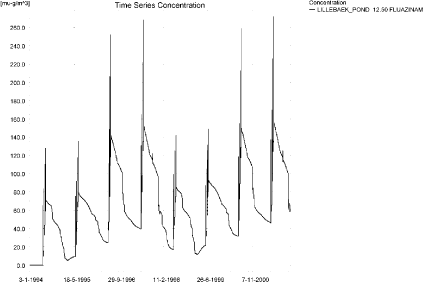
Figure 4.24. Concentrations of fluazinam for the sandy loam pond.
Figur 4.24. Koncentration af fluazinam i morænelersvandhullet.
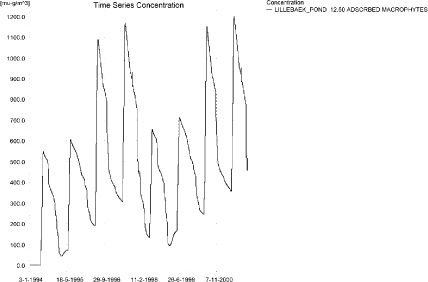
Figure 4.25. Fluazinam sorbed to the macrophytes in the sandy loam pond.
Figur 4.25. fluazinam sorberet til makrofytter i morænelers-vandhullet.
Figure 4.25 shows that the macrophytes participate strongly in the regulation of the concentrations in the pond. The maximum concentration is very high in relative terms, 1199 ng/l, about four times the water concentration, and thus influences the simulation results significantly. The concentration in the porewater is shown in Figure 4.26 and the concentration in sediment in Figure 4.27. The maximum value is 40 ng/kg.
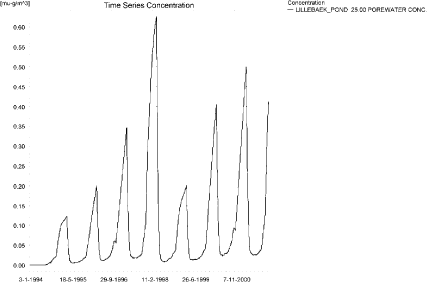
Figure 4.26. Porewater concentration of fluazinam in the sandy loam pond.
Figur 4.26. Porevandskoncentration af fluazinam i morænelersvandhullet.
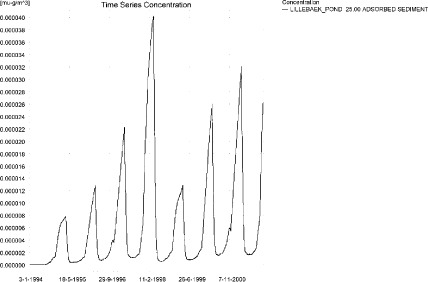
Figure 4.27. Fluazinam adsorbed to sediment in the sandy loam pond. The concentration is in µg/g sediment and not µg/m³ as stated.
Figur 4.27. Fluazinam adsorberet til sediment i morænelersvandhullet. Koncentrationen er i µg/g sediment of ikke µg/m³ som angivet.
In Table 4.11, global maxima and time weighted concentrations (up to 7 days) were extracted.
Table 4.11. Actual and time weighted concentrations of fluazinam, ng/l, in the sandy loam pond.
Tabel 4.11. Beregnede og tidsvægtede koncentrationer (ng/l) af fluazinam i morænelersvandhullet.
| Year | Fluazinam | actual | Time-weighted | Date |
| 1994 | global max | 128 | 01-07-1994 08:30 | |
| 1 hour(after max) | 108 | 116 | ||
| 1 day after sp.in. | 71 | 78 | ||
| 3 days | 70 | 73 | ||
| 4 days | 70 | 72 | ||
| 7 days | 71 | 71 | ||
| 1995 | Global max | 136 | 01-07-1995 08:30 | |
| 1 hour | 115 | 124 | ||
| 1 day | 79 | 86 | ||
| 2 days | 78 | 80 | ||
| 4 days | 78 | 80 | ||
| 7 days | 79 | 79 | ||
| 1996 | global max | 252 | 01-07-1996 08:30 | |
| 1 hour | 202 | 222 | ||
| 1 day | 141 | 153 | ||
| 2 (3*)days | 138 | 143 | ||
| 4 days | 139 | 142 | ||
| 7 (6*)days | 142 | 141 | ||
| 1997 | global max | 268 | 01-07-1997 08:30 | |
| 1 hour | 216 | 237 | ||
| 1 day | 153 | 165 | ||
| 2 (3*)days | 150 | 155 | ||
| 4 days | 150 | 154 | ||
| 7 (6*)days | 152 | 152 | ||
| 1998 | global max | 142 | 30-06-1998 08:30 | |
| 1 hour | 122 | 130 | ||
| 1 day | 85 | 92 | ||
| 2 (3*)days | 84 | 87 | ||
| 4 days | 84 | 86 | ||
| 7 (6*)days | 85 | 85 | ||
| 1999 | global max | 149 | 30-06-1999 08:30 | |
| 1 hour | 129 | 137 | ||
| 1 day | 92 | 99 | ||
| 2 (3*)days | 91 | 94 | ||
| 4 days | 91 | 93 | ||
| 7 (6*)days | 92 | 93 | ||
| 2000 | global max | 259 | 30-06-2000 08:30 | |
| 1 hour | 209 | 229 | ||
| 1 day | 148 | 160 | ||
| 2 (3*)days | 146 | 150 | ||
| 4 days | 147 | 149 | ||
| 7 (6*)days | 150 | 149 | ||
| 2001 | global max | 272 | 30-06-2001 08:30 | |
| 1 hour | 220 | 240 | ||
| 1 day | 157 | 169 | ||
| 2 (3*)days | 153 | 159 | ||
| 4 days | 154 | 157 | ||
| 7 (6*)days | 156 | 156 | ||
| max values | ||||
| global max | ||||
| 1 hour | 272 | |||
| 1 day | 220 | 240 | ||
| 2 days | 157 | 169 | ||
| 4 days | 153 | 159 | ||
| 7 days | 154 | 157 |
Figure 4.28 shows the output from the PestSurf template (page- lowest detection limit), with a time series identical to Figure 4.24.
The FOCUS SW-scenario D4-pond generates a concentration of 83 ng/l, which is lower, but in the same order of magnitude, as the PestSurf sandy loam pond-concentration of 272 ng/l. However, the sum of the concentration in macrophytes and in the water phase is 1471 ng/l. More solute is thus present in the PestSurf pond than in the D4-pond. One reason for the difference is the difference in size between the two ponds: 250 m² against 900 m² and the difference in water depth during the summer period. For this particular compound, the PestSurf pond receives more pesticide than the D4 pond, because FOCUS SW reduces the load per application when more applications are relevant.
The sediment concentration in PestSurf is lower that in the D4-pond, 40 ng/kg against 148 ng/kg.
The FOCUS SW concentration is generated through drift, while the PestSurf concentration is generated through a combination of drift and drainage.
Click here to see Figure 4.28.
Figure 4.28. Overview for Fluazinam in the sandy loam pond generated by the PestSurf excel template. The time series shown is identical to the one in Figure 4.24. The detection value was set to 75 ng/l.
Figur 4.28. Oversigt for fluazinam i morænelersoplandet genereret med PestSurf-excel-skabelonen. Den viste tidsserie er mage til den i Figur 4.24. Detektionsgrænsen er sat til 75 ng/l.
Table 4.12. Part of the result sheet generated by the PestSurf Excel sheet. The detection value is set t 75 ng/l. The toxicity values for fish, daphnies and algae were set to 15, 20 and 25 ng/l, respectively. The recorded peaks are shown in Figure 4.28.
Tabel 4.12. Uddrag af resultatpresentationen genereret af PestSurf-Excel-arket. Detektionsgrænsen er sat til 75 ng/l. Toxicitetsværdierne for fisk, dafnier og alger er henholdsvis 15, 20 og 25 ng/l. De tabellerede hændelser er vist i Figur 4.28.
Table 4.13. Summary of simulation results for Fluazinam.
Tabel 4.13. Opsummerede resultater for fluazinam.
4.5 Summary of simulations
The maximum actual concentrations for all simulations are recorded in Table 4.13.
The concentrations generated by PestSurf differ considerably between catchments and scenarios. The concentration generated for the sandy pond and stream are much larger than for the FOCUS SW D3-ditch. The reason for the high pond concentration is the addition of fluazinam through the groundwater. For the sandy stream, the continuous spraying of a long stretch together with a limited water depth causes the high concentrations. The maximum concentration reached 112 m from the upstream end of the sandy stream is 370 ng/l, and this value is more comparable to the 614 ng/l found for the D3-ditch. In PestSurf, however, the stretch is protected by a 20-m buffer zone, causing a reduction in the dose of a factor 13.6[1]. The water depth at the time of spraying is about 7 cm. Part of the difference is due to the smaller dose used in the FOCUS SW-simulations for compounds with several applications.
The sandy loam pond and the FOCUS D4-pond is within a factor of 3.3 of each other. However, the sum of the concentration in macrophytes and in the water phase is 1471 ng/l. More solute is thus present in the PestSurf pond than in the D4-pond. One reason for the difference is the difference in size between the two ponds: 250 m² against 900 m² and the difference in water depth during the summer period. For this particular compound, the PestSurf pond receives more pesticide than the D4 pond, because FOCUS SW reduces the load per application when more applications per year are practised.
For the sandy loam stream, the maximum concentrations are generated by the 20-year event for most of the catchment. The maximum value is much larger than what is generated by FOCUS SW. A similar situation is not present in the FOCUS SW- scenarios. 125 m from the upstream end is a point with a maximum value caused by drift. The maximum value here is 5380 ng/l, which is considerably higher than the FOCUS value of 497 ng/l. The water depth in the PestSurf point at the time is only about 5 cm at the time of spraying, but the additional difference could be due to the reduction in drift dose with more application times in FOCUS SW.
In the downstream end of the sandy loam catchment, the effect of spraying long stretches becomes important. At the same time, the high concentrations occurring in the lower part of the sandy loam catchment are also caused by contributions from groundwater flow. Fluazinam has a a relatively high DT50 value, meaning that pesticide percolated below the plough layer degrades very slowly. However, as mentioned earlier, the transport to groundwater is considered to be overestimated by the model (fluaziam is fairly strongly bound to soil particles and transported through macropores).
The highest concentration in the sandy loam catchment is reached in a tributary and is due to the 20-year-event. The water depth in June, at the time of spraying, is generally in the range of 5-8 cm.
Macrophytes influence all scenarios significantly, but particularly the sandy loam stream and pond. The concentrations in the water phase are strongly influenced and reduced by the presence of macrophytes.
The concentration in sediment in the sandy pond is considerably higher than in the D3-ditch, which is a function of the higher water concentration and the very long exposure time. Most of the simulation has water concentrations above 2 µg/l. For the sandy loam pond scenario, the sediment concentration is lower than in the corresponding FOCUS SW-scenario. Although the maximum water concentration is higher in the sandy loam loam pond than in the FOCUS D4-pond, it is still much lower than in the sandy pond and do not lead to similar sediment concentrations.
The groundwater buildup of active substance means that the concentration in the water phase is high for a long period of time and this influences the sediment concentration. As a result, the sediment concentration in the sandy loam stream is slightly higher than the concentration in the D4-stream.
The highly different conditions warrant an evaluation of what is more realistic. First of all, potatoes cannot be grown on the same piece of land year after year. The idea of spraying all agricultural land 8 years in a row with a compound used for potato is therefore not realistic. The high concentration found in the sandy poind is, as mentioned earlier, not so realistic because of the undrained conditions. The concentration in the sandy stream, however, is realistic, assuming that a long streach of stream is sprayed.
The sandy loam pond is realistic too with respect to its physical description. For the sandy loam stream, the 20-year event included in the simulation has taken place, and as drainage contributions were quite well simulated during the calibration phase, it is, as such a realistic event. It occurs already in the first year of simulation and no strong buildup in groundwater concentrations has taken place at this time.
The groundwater concentration is exaggerated though. To avoid this influence it is recommended to extract values between 500 m and 1700 m from the upstream end. In this case, the value is 18.9 µg/l, and caused by drainage. Generally, the flow conditions and water depths used in FOCUS are not representative for 1. order stream systems in Denmark, particularl taking into account the catchment size they are supposed to represent.
Footnotes
[1] The factor is crop dependent as it is the dose at 20 m compared to the dose at the edge of the stream, which depends on buffer zone with and thus the crop in question.
Version 1.0 December 2006, © Danish Environmental Protection Agency